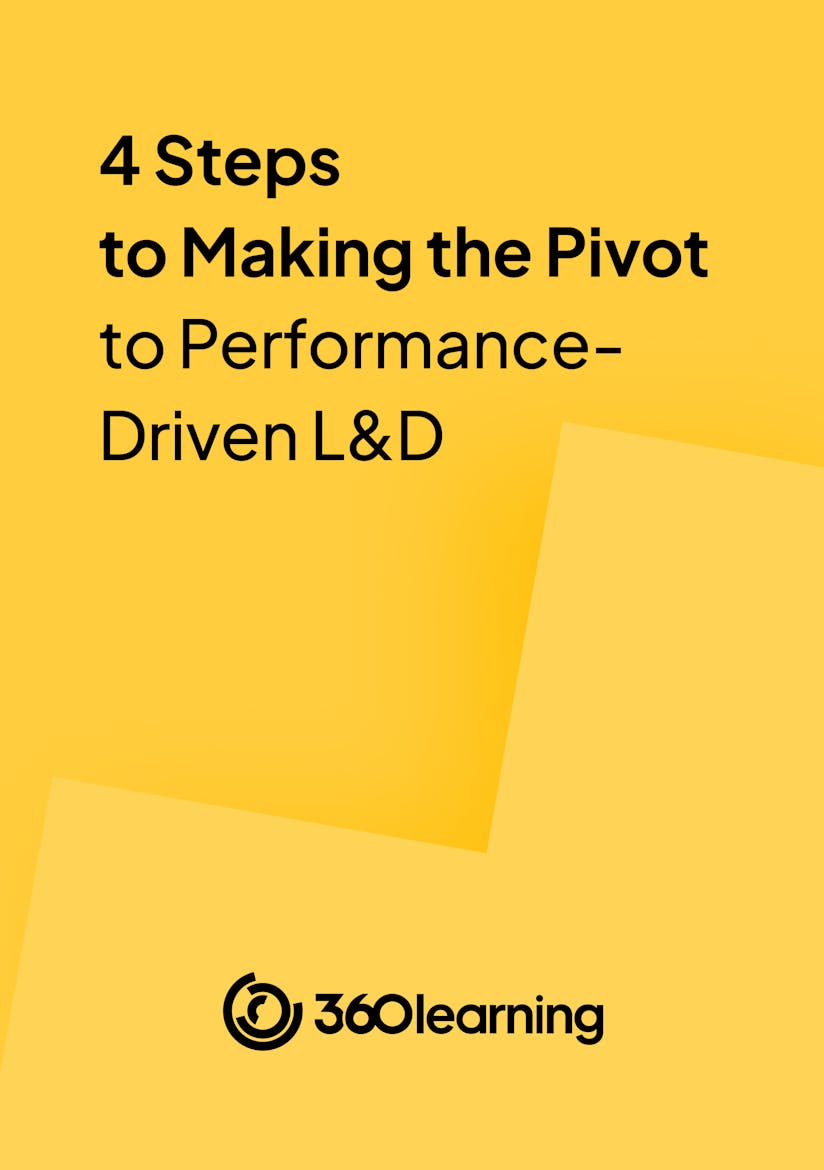
The Data Game Matters: Leveraging Skills Intelligence With L&D Leader Peter Sheppard
Today, L&D teams are feeling the pressure. Statistics show that around 80% of the workforce in 2030 are already in the workforce today, but the half-life of skills is also decreasing.
The vast majority of people in the workforce can expect to reskill during the next eight to 10 years. This places a great deal of onus on the L&D function to achieve demonstrable results.
In this L&D Podcast episode, I speak with Peter Sheppard, Global Head of L&D Ecosystems at Ericsson, about his experience leading an L&D team as they tackle their skills challenges in a global blue chip tech company.
Read on to hear about the critical factors driving the interest in skills, the three pressures that Peter and his team face, and their four-phased approach for harvesting skills data at scale.
But first, what does the global L&D function look like in a telecommunications company like Ericsson?
L&D within a global organizational ecosystem
At Ericsson, Peter and his team are responsible for the end-to-end infrastructure of the learning environment.
“That's anything from technology through to skills and jobs frameworks to analytics and administration,” Peter explains. “This is what I mean by an ecosystem.”
Ericsson makes people’s mobile phones work for them and is responsible for creating a lot of the globe’s telecom network infrastructure. Peter has over a hundred thousand colleagues working to make that happen in around 180 countries.
“We do a lot of the network infrastructure around 5G,” he says. “For example, we now have 5G in at least 130 live networks in around 55 countries.”
So, what’s Peter’s take on the considerable interest in skills amongst L&D teams and business leaders?

Impactful, demonstrable L&D in 4 simple steps
By providing your contact info, you agree to receive communications from 360Learning. You can opt-out at any time. For details, refer to our Privacy Policy.
Why is there an increasing interest in skills?
In Peter’s experience, there are three main components to the increased interest in skills in L&D: the interests of the organization, the HR function, and the individual.
First, he finds that there is an increasing interest in skills because most organizations are always trying to think about what can give them a competitive edge. “Skills are one of the many variables that influence that competitive edge,” he explains.
“Secondly, it’s about whether you've got the right mix of skills, and this is something that L&D teams can influence and take the lead on,” Peter says. “Whether you are in the reward function, the L&D function, or recruitment, skills become relevant. So, I think there's an interest because it runs across so many of our functions.”
Skills are one of the many variables that influence an organizations' competitive edge.
And the third reason Peter outlines is the individual component, where all employees want to drive their careers. As everyone moves away from the old hierarchical jobs towards more networked careers, people are thinking about navigating the shift and what will make a difference to their careers.
But these interests in skills build pressure on the L&D team, and Peter and his team are working to alleviate this by ramping up their skills development work.
The pressures that drive upskilling at Ericsson
As Peter explains, three pressures are driving the work he and his team are doing to address the challenges of upskilling and reskilling employees in their global organization.
1. Understand the skills you have
“First, there's an element of frustration in that we need to better understand the skills that we have at Ericsson,” Peter explains.
“We recruit over 10,000 people every year,” he says. “And we need to know the skills we've got once they’re on board.”
2. Identify the skills you need
The second frustration is that Peter and his team need to understand what skills they need to make them a successful organization.
Peter finds that there is a desire to have more targeted learning on developing specific skills, which helps you measure and understand whether the learning is making an impact.
“We describe ourselves as a technology-first company,” he says, “and if you're that sort of company, then clearly, technical skills matter.”
3. The desire for retention and mobility
Finally, Peter and the team have identified that people stay in the organization primarily because they want to see mobility and career growth.
“So if we can do better,” he says, “then focusing on skills can make that happen. That's why we are bringing in talent marketplaces where you match the skills to the opportunities, but that pairing can only be done well if you have skills data. So in this case, skills is a bit of a data game.”
“If you can upskill and reskill your existing employees,” he adds, “then that's cheaper than recruitment. Full stop. I think sometimes L&D teams don’t push hard enough for internal upskilling. At the end of the day, it is more cost-effective, more engaging, and has more effect on retention.”
If you can upskill and reskill your existing employees, then that's cheaper than recruitment. Full stop. I think sometimes L&D teams don’t push hard enough for internal upskilling. At the end of the day, it is more cost-effective, more engaging, and has more effect on retention.
To alleviate these pressures, Peter and the team have implemented a four-phased approach that lays the foundation for harvesting skills data.
Related: Upskilling: The Key to Organizational Success in a Recession
A 4-phased approach for harvesting skills data
When collecting skills data, Peter and the team have focused on creating a solid platform for upskilling their learners and driving real impact.
First up, you need to start with your organizations' skill architecture.
1. Automate your job and skills architecture
Peter and his team are automating and simplifying their job and skills architecture.
“By automating,” he says, “I mean that we are firstly digitizing all of our jobs, but also automating the sourcing of a skills taxonomy to an external company, and that means that the skills are updated regularly.”
They are also bringing in skills intelligence to identify the skills that are emerging, growing, or declining to get a feel for what is happening in the marketplace.
2. Leverage skills intelligence
Next, you can use your skills intelligence to create reports and target critical skills areas.
“Last year, we had our first go at creating an annual skills report of the skills that we’ve got in Ericsson and how those skills compare to external benchmarks to get a feel if we are doing well in developing our skills,” Peter explains.
“And then how we are doing in specific targeted areas,” he says. “We started targeting eight critical skill areas. We worked with our strategy teams to identify the skills that will make a difference in fulfilling Ericsson’s future strategy.”
3. Design targeted learning journeys
Next, Peter and the team create targeted learning journeys with their eight critical skill areas.
“This helps us to see the progress we are making in developing these skills. In the end, identifying them is one thing, but we've got to be able to show that we are making progress in developing some specific skills and then be prepared to change them as well,” he says.
4. Show skills progression
Finally, Peter and the team have set targets for those eight critical skills areas and are tracking their progress on how much development drives skill progression.
“But I'm not sure we’ve escaped the old problem entirely,” he says, “If a learner has completed a learning program, do they have the new skill, and as a result, have the L&D team made an impact? We are still trying to progress on that and show that we can do more than just completions.”
If you’re inspired to start harvesting skills data to ramp up upskilling in your organization, Peter’s got a great tip to get you started.
Related: Go Beyond Learning Metrics: Our 6-Step Expert Playbook for Proving Your L&D Impact
Peter's tips to help you get started
Peter advises that your skills data harvesting and upskilling journey starts with solving performance problems.
“Start to look at what performance problems, either at the organizational level or within the team level, you are trying to solve,” he explains. “Is there a team in particular that wants to understand what skills will make a difference in that team?
Next, he advises that you identify the pain points and show the value of solving them, what that means for business numbers, and the real business impact it will make.
“When you’ve got that platform, go out and experiment. If there’s one mistake that we made, it was that we tried to boil the ocean too early. So, keep it focused on experiments where you can show that if you do take a skills approach, this is the impact that it can have, and then grow it from there.” he says.
Thanks to Peter for sharing his insights and experience with us! Keen to learn more from L&D experts? Check out the episode where David and Guy Wallace speak to a panel of five learning and development experts about the balance between performance-oriented and professional development in L&D.
Want more peer insights on transforming workplace learning? Sign up to become a member of the L&D Collective, and check out our other #CLOConnect interviews with top L&D leaders on driving growth and scaling culture through Collaborative Learning. Or you can subscribe (below 👇) to our weekly newsletter to receive our latest posts directly in your inbox.


